Economic Analysis: World Bank's Interpretation of East Asian Growth
VerifiedAdded on 2023/06/15
|11
|2589
|483
Essay
AI Summary
This essay critically examines the World Bank's 1993 report, "East Asian Miracle," focusing on its interpretation of the rapid economic growth experienced by East Asian countries. The essay discusses the World Bank's emphasis on free market principles, capitalist expansion, comparative advantage, and export-oriented strategies as key drivers of this growth. It argues that the World Bank's analysis exhibits a neoliberal bias by downplaying the significant role of state intervention and strategic economic frameworks in the success of these economies. The essay also highlights the report's potential influence from Japanese economic models and its limited focus on the social welfare aspects of economic development in the region. Ultimately, the essay concludes that the East Asian growth was not merely a "miracle" but a result of complex and multifaceted factors, including effective government policies alongside market-oriented reforms.
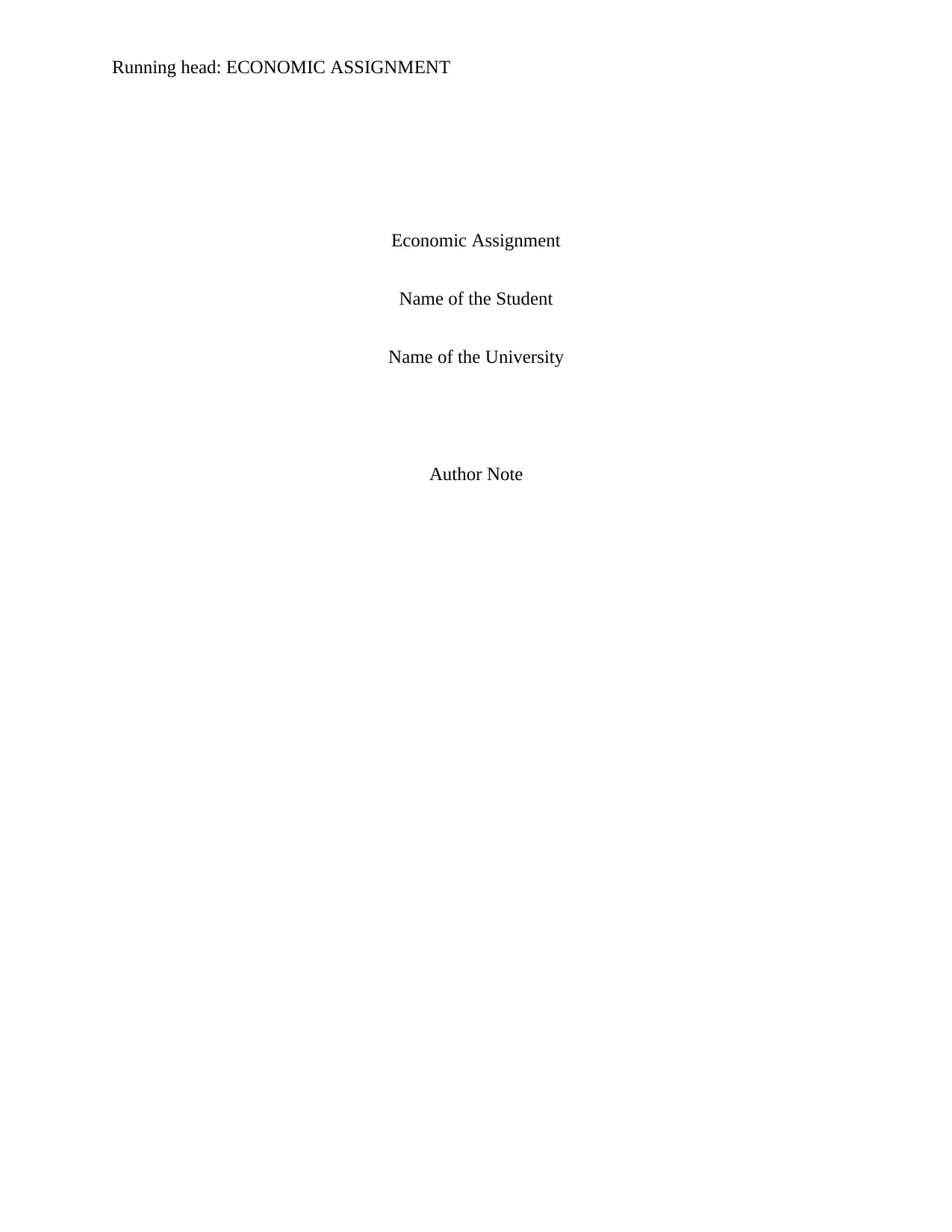
Running head: ECONOMIC ASSIGNMENT
Economic Assignment
Name of the Student
Name of the University
Author Note
Economic Assignment
Name of the Student
Name of the University
Author Note
Paraphrase This Document
Need a fresh take? Get an instant paraphrase of this document with our AI Paraphraser
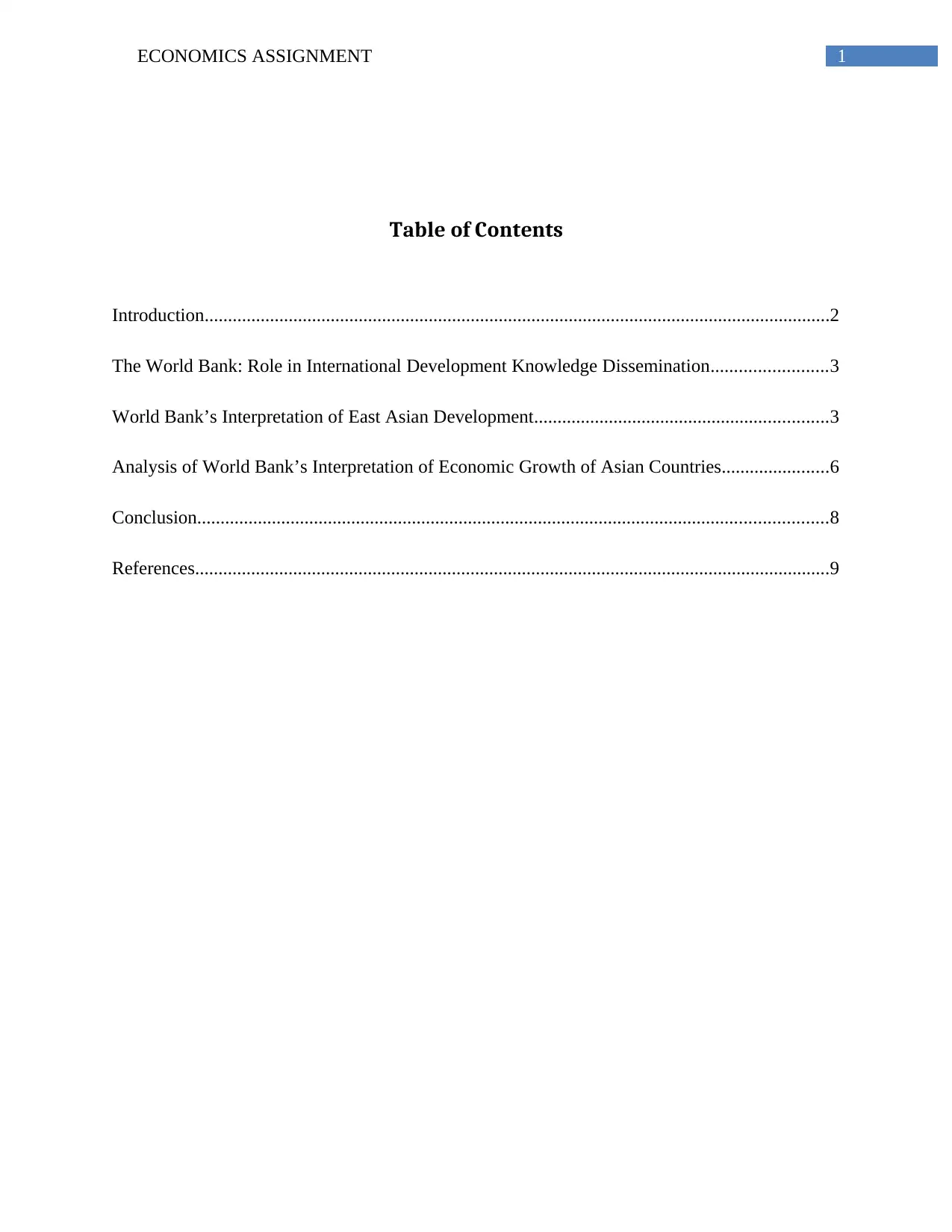
1ECONOMICS ASSIGNMENT
Table of Contents
Introduction......................................................................................................................................2
The World Bank: Role in International Development Knowledge Dissemination.........................3
World Bank’s Interpretation of East Asian Development...............................................................3
Analysis of World Bank’s Interpretation of Economic Growth of Asian Countries.......................6
Conclusion.......................................................................................................................................8
References........................................................................................................................................9
Table of Contents
Introduction......................................................................................................................................2
The World Bank: Role in International Development Knowledge Dissemination.........................3
World Bank’s Interpretation of East Asian Development...............................................................3
Analysis of World Bank’s Interpretation of Economic Growth of Asian Countries.......................6
Conclusion.......................................................................................................................................8
References........................................................................................................................................9
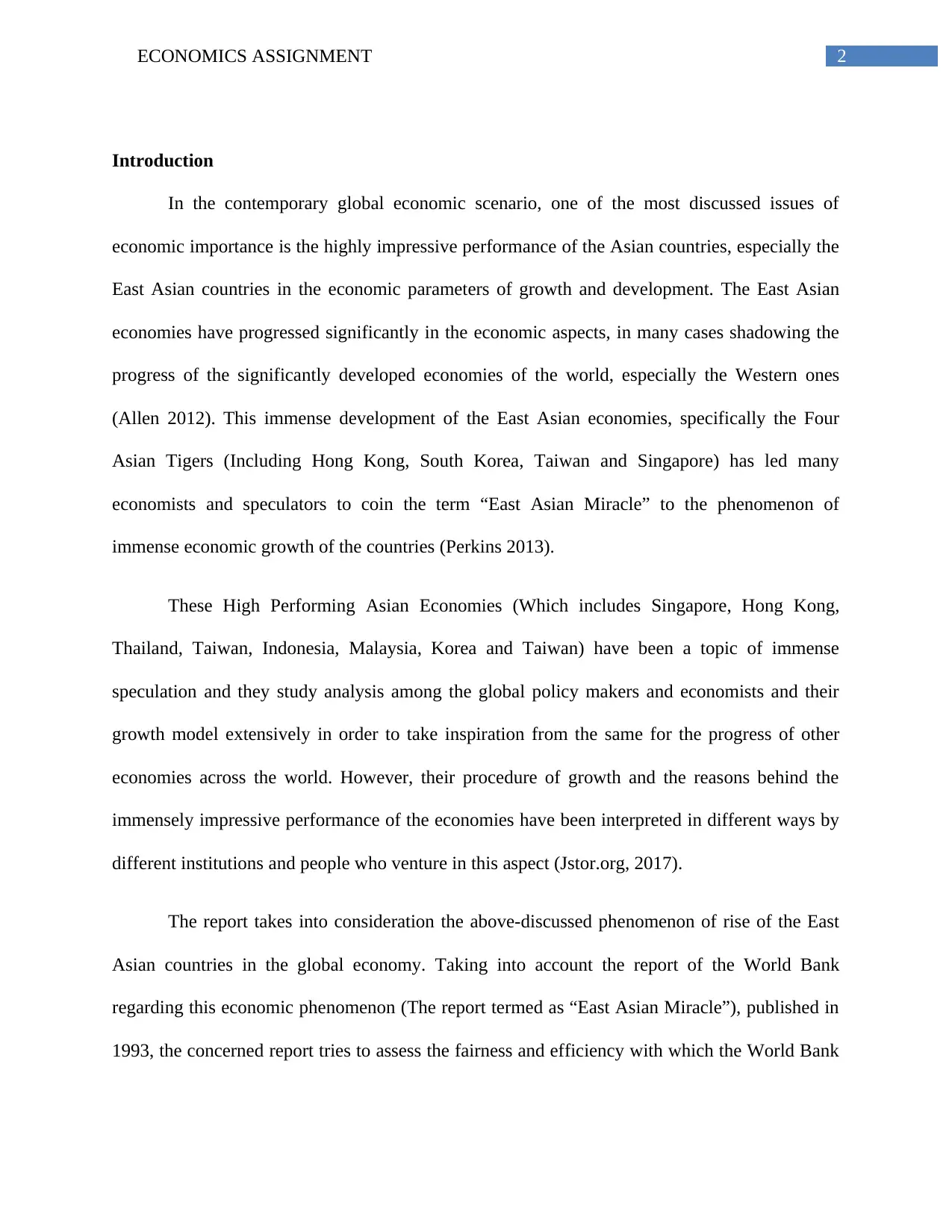
2ECONOMICS ASSIGNMENT
Introduction
In the contemporary global economic scenario, one of the most discussed issues of
economic importance is the highly impressive performance of the Asian countries, especially the
East Asian countries in the economic parameters of growth and development. The East Asian
economies have progressed significantly in the economic aspects, in many cases shadowing the
progress of the significantly developed economies of the world, especially the Western ones
(Allen 2012). This immense development of the East Asian economies, specifically the Four
Asian Tigers (Including Hong Kong, South Korea, Taiwan and Singapore) has led many
economists and speculators to coin the term “East Asian Miracle” to the phenomenon of
immense economic growth of the countries (Perkins 2013).
These High Performing Asian Economies (Which includes Singapore, Hong Kong,
Thailand, Taiwan, Indonesia, Malaysia, Korea and Taiwan) have been a topic of immense
speculation and they study analysis among the global policy makers and economists and their
growth model extensively in order to take inspiration from the same for the progress of other
economies across the world. However, their procedure of growth and the reasons behind the
immensely impressive performance of the economies have been interpreted in different ways by
different institutions and people who venture in this aspect (Jstor.org, 2017).
The report takes into consideration the above-discussed phenomenon of rise of the East
Asian countries in the global economy. Taking into account the report of the World Bank
regarding this economic phenomenon (The report termed as “East Asian Miracle”), published in
1993, the concerned report tries to assess the fairness and efficiency with which the World Bank
Introduction
In the contemporary global economic scenario, one of the most discussed issues of
economic importance is the highly impressive performance of the Asian countries, especially the
East Asian countries in the economic parameters of growth and development. The East Asian
economies have progressed significantly in the economic aspects, in many cases shadowing the
progress of the significantly developed economies of the world, especially the Western ones
(Allen 2012). This immense development of the East Asian economies, specifically the Four
Asian Tigers (Including Hong Kong, South Korea, Taiwan and Singapore) has led many
economists and speculators to coin the term “East Asian Miracle” to the phenomenon of
immense economic growth of the countries (Perkins 2013).
These High Performing Asian Economies (Which includes Singapore, Hong Kong,
Thailand, Taiwan, Indonesia, Malaysia, Korea and Taiwan) have been a topic of immense
speculation and they study analysis among the global policy makers and economists and their
growth model extensively in order to take inspiration from the same for the progress of other
economies across the world. However, their procedure of growth and the reasons behind the
immensely impressive performance of the economies have been interpreted in different ways by
different institutions and people who venture in this aspect (Jstor.org, 2017).
The report takes into consideration the above-discussed phenomenon of rise of the East
Asian countries in the global economy. Taking into account the report of the World Bank
regarding this economic phenomenon (The report termed as “East Asian Miracle”), published in
1993, the concerned report tries to assess the fairness and efficiency with which the World Bank
⊘ This is a preview!⊘
Do you want full access?
Subscribe today to unlock all pages.

Trusted by 1+ million students worldwide
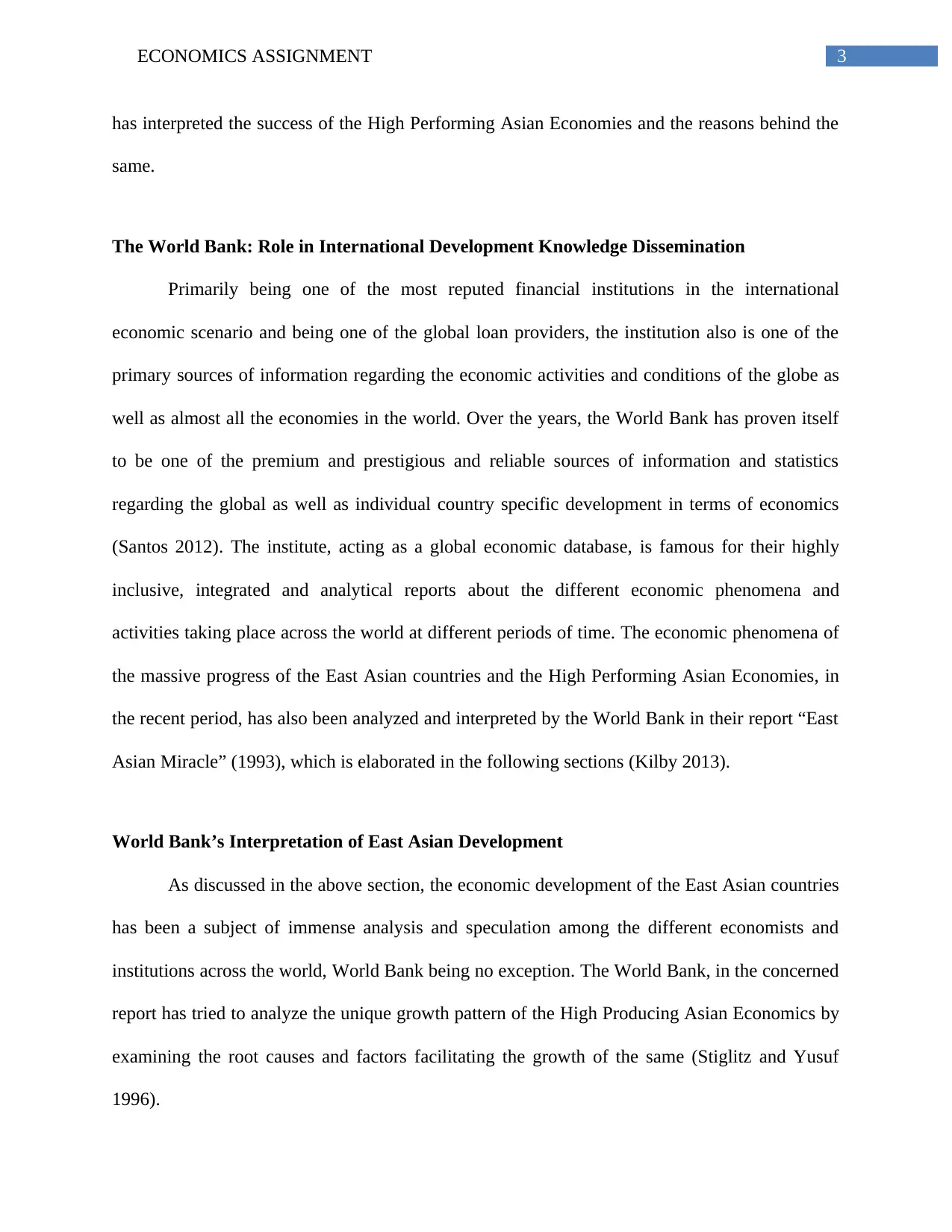
3ECONOMICS ASSIGNMENT
has interpreted the success of the High Performing Asian Economies and the reasons behind the
same.
The World Bank: Role in International Development Knowledge Dissemination
Primarily being one of the most reputed financial institutions in the international
economic scenario and being one of the global loan providers, the institution also is one of the
primary sources of information regarding the economic activities and conditions of the globe as
well as almost all the economies in the world. Over the years, the World Bank has proven itself
to be one of the premium and prestigious and reliable sources of information and statistics
regarding the global as well as individual country specific development in terms of economics
(Santos 2012). The institute, acting as a global economic database, is famous for their highly
inclusive, integrated and analytical reports about the different economic phenomena and
activities taking place across the world at different periods of time. The economic phenomena of
the massive progress of the East Asian countries and the High Performing Asian Economies, in
the recent period, has also been analyzed and interpreted by the World Bank in their report “East
Asian Miracle” (1993), which is elaborated in the following sections (Kilby 2013).
World Bank’s Interpretation of East Asian Development
As discussed in the above section, the economic development of the East Asian countries
has been a subject of immense analysis and speculation among the different economists and
institutions across the world, World Bank being no exception. The World Bank, in the concerned
report has tried to analyze the unique growth pattern of the High Producing Asian Economics by
examining the root causes and factors facilitating the growth of the same (Stiglitz and Yusuf
1996).
has interpreted the success of the High Performing Asian Economies and the reasons behind the
same.
The World Bank: Role in International Development Knowledge Dissemination
Primarily being one of the most reputed financial institutions in the international
economic scenario and being one of the global loan providers, the institution also is one of the
primary sources of information regarding the economic activities and conditions of the globe as
well as almost all the economies in the world. Over the years, the World Bank has proven itself
to be one of the premium and prestigious and reliable sources of information and statistics
regarding the global as well as individual country specific development in terms of economics
(Santos 2012). The institute, acting as a global economic database, is famous for their highly
inclusive, integrated and analytical reports about the different economic phenomena and
activities taking place across the world at different periods of time. The economic phenomena of
the massive progress of the East Asian countries and the High Performing Asian Economies, in
the recent period, has also been analyzed and interpreted by the World Bank in their report “East
Asian Miracle” (1993), which is elaborated in the following sections (Kilby 2013).
World Bank’s Interpretation of East Asian Development
As discussed in the above section, the economic development of the East Asian countries
has been a subject of immense analysis and speculation among the different economists and
institutions across the world, World Bank being no exception. The World Bank, in the concerned
report has tried to analyze the unique growth pattern of the High Producing Asian Economics by
examining the root causes and factors facilitating the growth of the same (Stiglitz and Yusuf
1996).
Paraphrase This Document
Need a fresh take? Get an instant paraphrase of this document with our AI Paraphraser
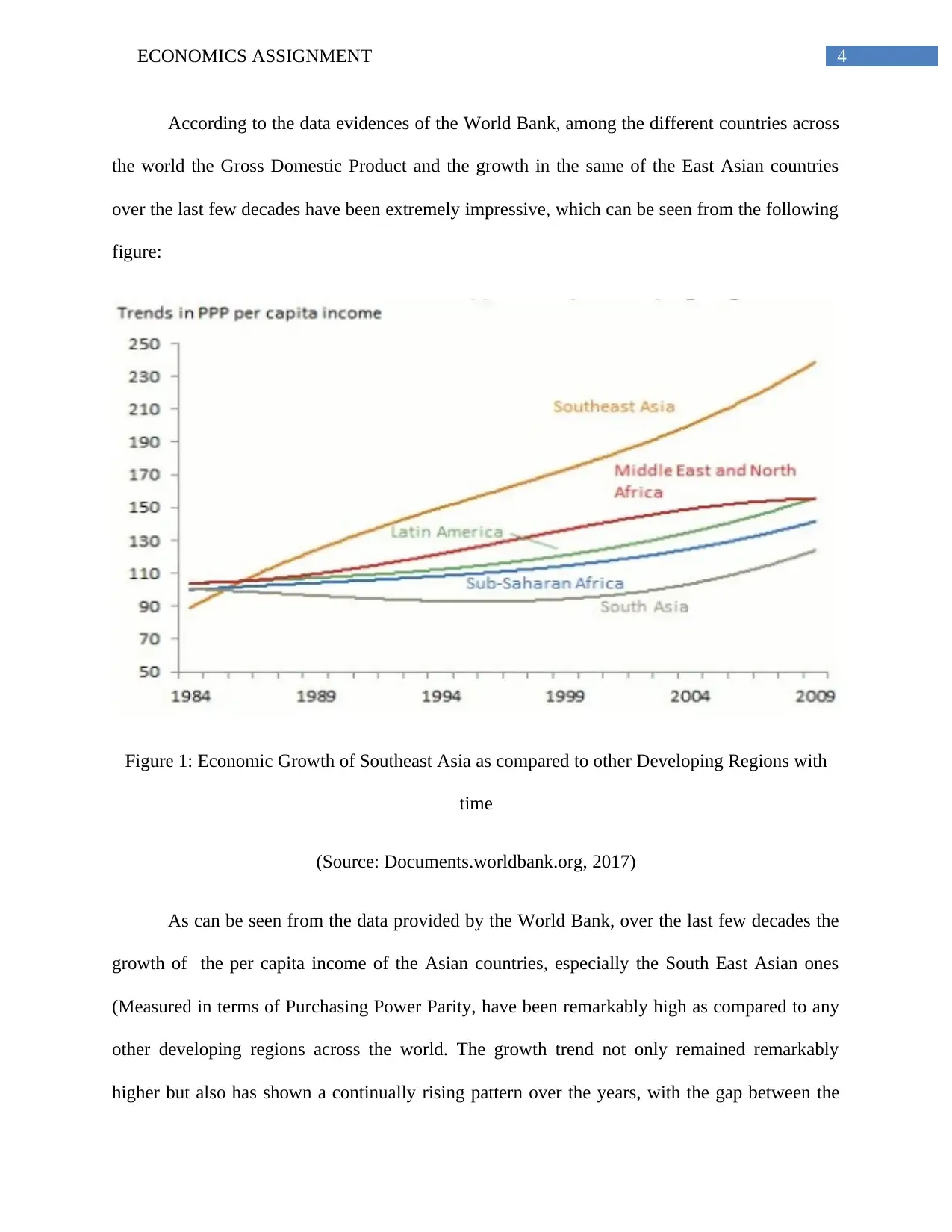
4ECONOMICS ASSIGNMENT
According to the data evidences of the World Bank, among the different countries across
the world the Gross Domestic Product and the growth in the same of the East Asian countries
over the last few decades have been extremely impressive, which can be seen from the following
figure:
Figure 1: Economic Growth of Southeast Asia as compared to other Developing Regions with
time
(Source: Documents.worldbank.org, 2017)
As can be seen from the data provided by the World Bank, over the last few decades the
growth of the per capita income of the Asian countries, especially the South East Asian ones
(Measured in terms of Purchasing Power Parity, have been remarkably high as compared to any
other developing regions across the world. The growth trend not only remained remarkably
higher but also has shown a continually rising pattern over the years, with the gap between the
According to the data evidences of the World Bank, among the different countries across
the world the Gross Domestic Product and the growth in the same of the East Asian countries
over the last few decades have been extremely impressive, which can be seen from the following
figure:
Figure 1: Economic Growth of Southeast Asia as compared to other Developing Regions with
time
(Source: Documents.worldbank.org, 2017)
As can be seen from the data provided by the World Bank, over the last few decades the
growth of the per capita income of the Asian countries, especially the South East Asian ones
(Measured in terms of Purchasing Power Parity, have been remarkably high as compared to any
other developing regions across the world. The growth trend not only remained remarkably
higher but also has shown a continually rising pattern over the years, with the gap between the
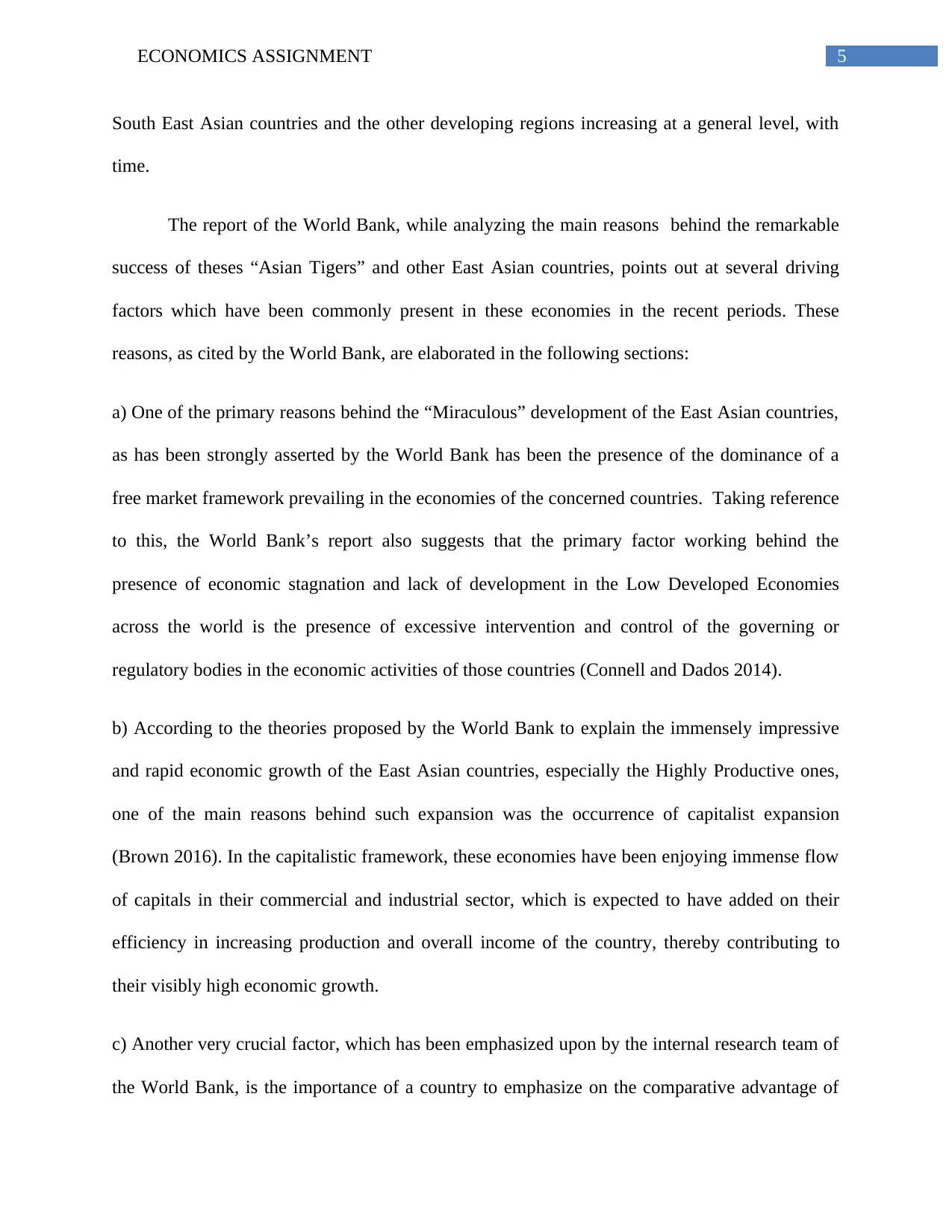
5ECONOMICS ASSIGNMENT
South East Asian countries and the other developing regions increasing at a general level, with
time.
The report of the World Bank, while analyzing the main reasons behind the remarkable
success of theses “Asian Tigers” and other East Asian countries, points out at several driving
factors which have been commonly present in these economies in the recent periods. These
reasons, as cited by the World Bank, are elaborated in the following sections:
a) One of the primary reasons behind the “Miraculous” development of the East Asian countries,
as has been strongly asserted by the World Bank has been the presence of the dominance of a
free market framework prevailing in the economies of the concerned countries. Taking reference
to this, the World Bank’s report also suggests that the primary factor working behind the
presence of economic stagnation and lack of development in the Low Developed Economies
across the world is the presence of excessive intervention and control of the governing or
regulatory bodies in the economic activities of those countries (Connell and Dados 2014).
b) According to the theories proposed by the World Bank to explain the immensely impressive
and rapid economic growth of the East Asian countries, especially the Highly Productive ones,
one of the main reasons behind such expansion was the occurrence of capitalist expansion
(Brown 2016). In the capitalistic framework, these economies have been enjoying immense flow
of capitals in their commercial and industrial sector, which is expected to have added on their
efficiency in increasing production and overall income of the country, thereby contributing to
their visibly high economic growth.
c) Another very crucial factor, which has been emphasized upon by the internal research team of
the World Bank, is the importance of a country to emphasize on the comparative advantage of
South East Asian countries and the other developing regions increasing at a general level, with
time.
The report of the World Bank, while analyzing the main reasons behind the remarkable
success of theses “Asian Tigers” and other East Asian countries, points out at several driving
factors which have been commonly present in these economies in the recent periods. These
reasons, as cited by the World Bank, are elaborated in the following sections:
a) One of the primary reasons behind the “Miraculous” development of the East Asian countries,
as has been strongly asserted by the World Bank has been the presence of the dominance of a
free market framework prevailing in the economies of the concerned countries. Taking reference
to this, the World Bank’s report also suggests that the primary factor working behind the
presence of economic stagnation and lack of development in the Low Developed Economies
across the world is the presence of excessive intervention and control of the governing or
regulatory bodies in the economic activities of those countries (Connell and Dados 2014).
b) According to the theories proposed by the World Bank to explain the immensely impressive
and rapid economic growth of the East Asian countries, especially the Highly Productive ones,
one of the main reasons behind such expansion was the occurrence of capitalist expansion
(Brown 2016). In the capitalistic framework, these economies have been enjoying immense flow
of capitals in their commercial and industrial sector, which is expected to have added on their
efficiency in increasing production and overall income of the country, thereby contributing to
their visibly high economic growth.
c) Another very crucial factor, which has been emphasized upon by the internal research team of
the World Bank, is the importance of a country to emphasize on the comparative advantage of
⊘ This is a preview!⊘
Do you want full access?
Subscribe today to unlock all pages.

Trusted by 1+ million students worldwide
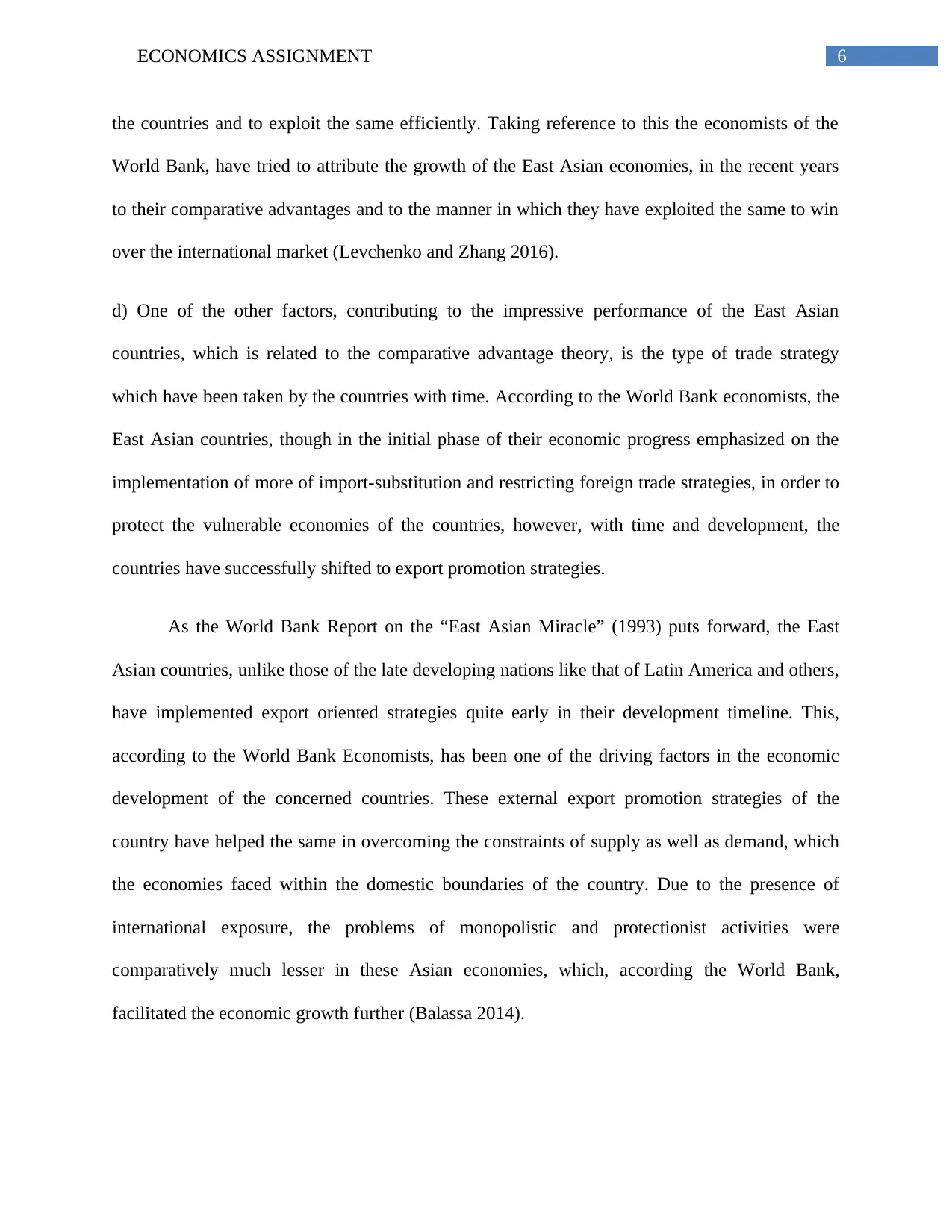
6ECONOMICS ASSIGNMENT
the countries and to exploit the same efficiently. Taking reference to this the economists of the
World Bank, have tried to attribute the growth of the East Asian economies, in the recent years
to their comparative advantages and to the manner in which they have exploited the same to win
over the international market (Levchenko and Zhang 2016).
d) One of the other factors, contributing to the impressive performance of the East Asian
countries, which is related to the comparative advantage theory, is the type of trade strategy
which have been taken by the countries with time. According to the World Bank economists, the
East Asian countries, though in the initial phase of their economic progress emphasized on the
implementation of more of import-substitution and restricting foreign trade strategies, in order to
protect the vulnerable economies of the countries, however, with time and development, the
countries have successfully shifted to export promotion strategies.
As the World Bank Report on the “East Asian Miracle” (1993) puts forward, the East
Asian countries, unlike those of the late developing nations like that of Latin America and others,
have implemented export oriented strategies quite early in their development timeline. This,
according to the World Bank Economists, has been one of the driving factors in the economic
development of the concerned countries. These external export promotion strategies of the
country have helped the same in overcoming the constraints of supply as well as demand, which
the economies faced within the domestic boundaries of the country. Due to the presence of
international exposure, the problems of monopolistic and protectionist activities were
comparatively much lesser in these Asian economies, which, according the World Bank,
facilitated the economic growth further (Balassa 2014).
the countries and to exploit the same efficiently. Taking reference to this the economists of the
World Bank, have tried to attribute the growth of the East Asian economies, in the recent years
to their comparative advantages and to the manner in which they have exploited the same to win
over the international market (Levchenko and Zhang 2016).
d) One of the other factors, contributing to the impressive performance of the East Asian
countries, which is related to the comparative advantage theory, is the type of trade strategy
which have been taken by the countries with time. According to the World Bank economists, the
East Asian countries, though in the initial phase of their economic progress emphasized on the
implementation of more of import-substitution and restricting foreign trade strategies, in order to
protect the vulnerable economies of the countries, however, with time and development, the
countries have successfully shifted to export promotion strategies.
As the World Bank Report on the “East Asian Miracle” (1993) puts forward, the East
Asian countries, unlike those of the late developing nations like that of Latin America and others,
have implemented export oriented strategies quite early in their development timeline. This,
according to the World Bank Economists, has been one of the driving factors in the economic
development of the concerned countries. These external export promotion strategies of the
country have helped the same in overcoming the constraints of supply as well as demand, which
the economies faced within the domestic boundaries of the country. Due to the presence of
international exposure, the problems of monopolistic and protectionist activities were
comparatively much lesser in these Asian economies, which, according the World Bank,
facilitated the economic growth further (Balassa 2014).
Paraphrase This Document
Need a fresh take? Get an instant paraphrase of this document with our AI Paraphraser
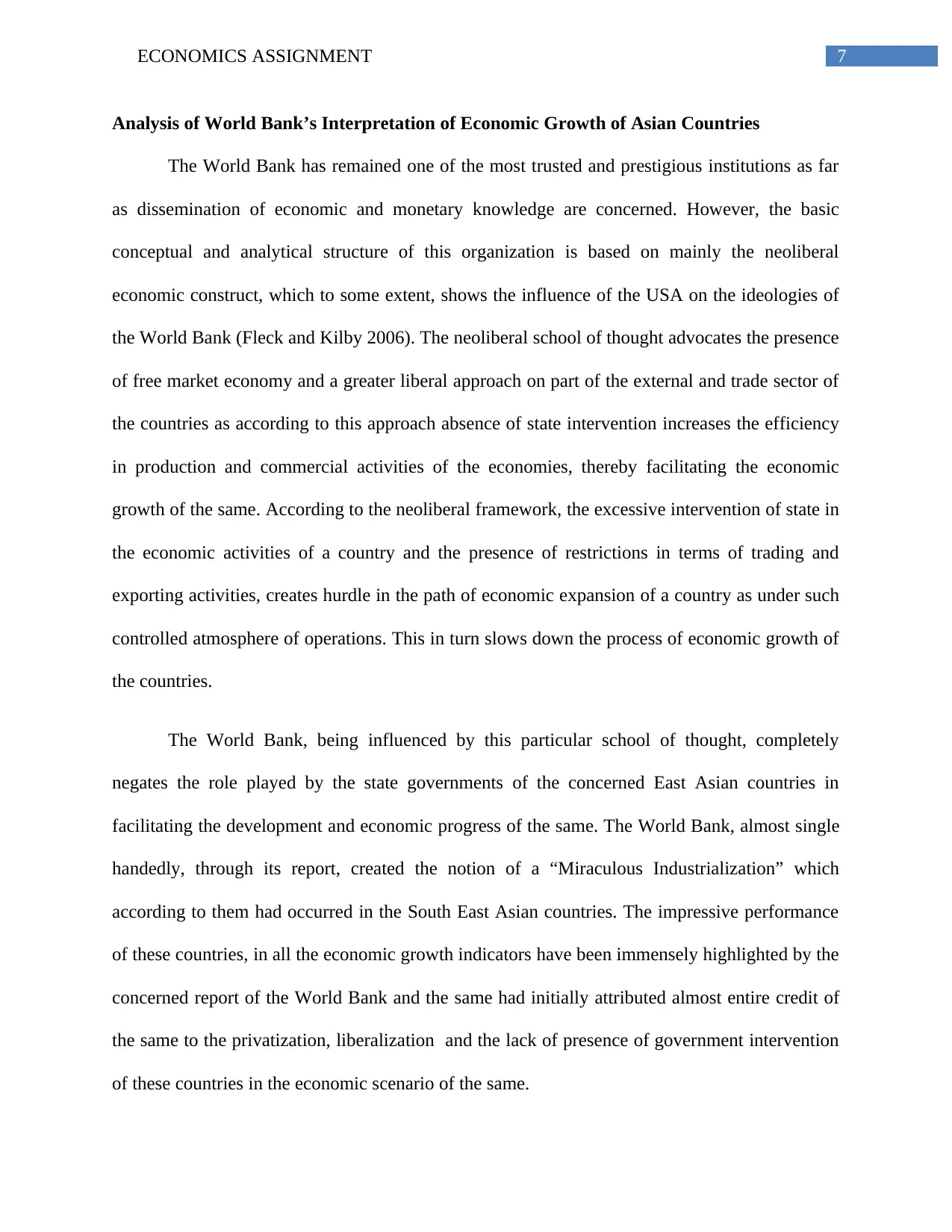
7ECONOMICS ASSIGNMENT
Analysis of World Bank’s Interpretation of Economic Growth of Asian Countries
The World Bank has remained one of the most trusted and prestigious institutions as far
as dissemination of economic and monetary knowledge are concerned. However, the basic
conceptual and analytical structure of this organization is based on mainly the neoliberal
economic construct, which to some extent, shows the influence of the USA on the ideologies of
the World Bank (Fleck and Kilby 2006). The neoliberal school of thought advocates the presence
of free market economy and a greater liberal approach on part of the external and trade sector of
the countries as according to this approach absence of state intervention increases the efficiency
in production and commercial activities of the economies, thereby facilitating the economic
growth of the same. According to the neoliberal framework, the excessive intervention of state in
the economic activities of a country and the presence of restrictions in terms of trading and
exporting activities, creates hurdle in the path of economic expansion of a country as under such
controlled atmosphere of operations. This in turn slows down the process of economic growth of
the countries.
The World Bank, being influenced by this particular school of thought, completely
negates the role played by the state governments of the concerned East Asian countries in
facilitating the development and economic progress of the same. The World Bank, almost single
handedly, through its report, created the notion of a “Miraculous Industrialization” which
according to them had occurred in the South East Asian countries. The impressive performance
of these countries, in all the economic growth indicators have been immensely highlighted by the
concerned report of the World Bank and the same had initially attributed almost entire credit of
the same to the privatization, liberalization and the lack of presence of government intervention
of these countries in the economic scenario of the same.
Analysis of World Bank’s Interpretation of Economic Growth of Asian Countries
The World Bank has remained one of the most trusted and prestigious institutions as far
as dissemination of economic and monetary knowledge are concerned. However, the basic
conceptual and analytical structure of this organization is based on mainly the neoliberal
economic construct, which to some extent, shows the influence of the USA on the ideologies of
the World Bank (Fleck and Kilby 2006). The neoliberal school of thought advocates the presence
of free market economy and a greater liberal approach on part of the external and trade sector of
the countries as according to this approach absence of state intervention increases the efficiency
in production and commercial activities of the economies, thereby facilitating the economic
growth of the same. According to the neoliberal framework, the excessive intervention of state in
the economic activities of a country and the presence of restrictions in terms of trading and
exporting activities, creates hurdle in the path of economic expansion of a country as under such
controlled atmosphere of operations. This in turn slows down the process of economic growth of
the countries.
The World Bank, being influenced by this particular school of thought, completely
negates the role played by the state governments of the concerned East Asian countries in
facilitating the development and economic progress of the same. The World Bank, almost single
handedly, through its report, created the notion of a “Miraculous Industrialization” which
according to them had occurred in the South East Asian countries. The impressive performance
of these countries, in all the economic growth indicators have been immensely highlighted by the
concerned report of the World Bank and the same had initially attributed almost entire credit of
the same to the privatization, liberalization and the lack of presence of government intervention
of these countries in the economic scenario of the same.
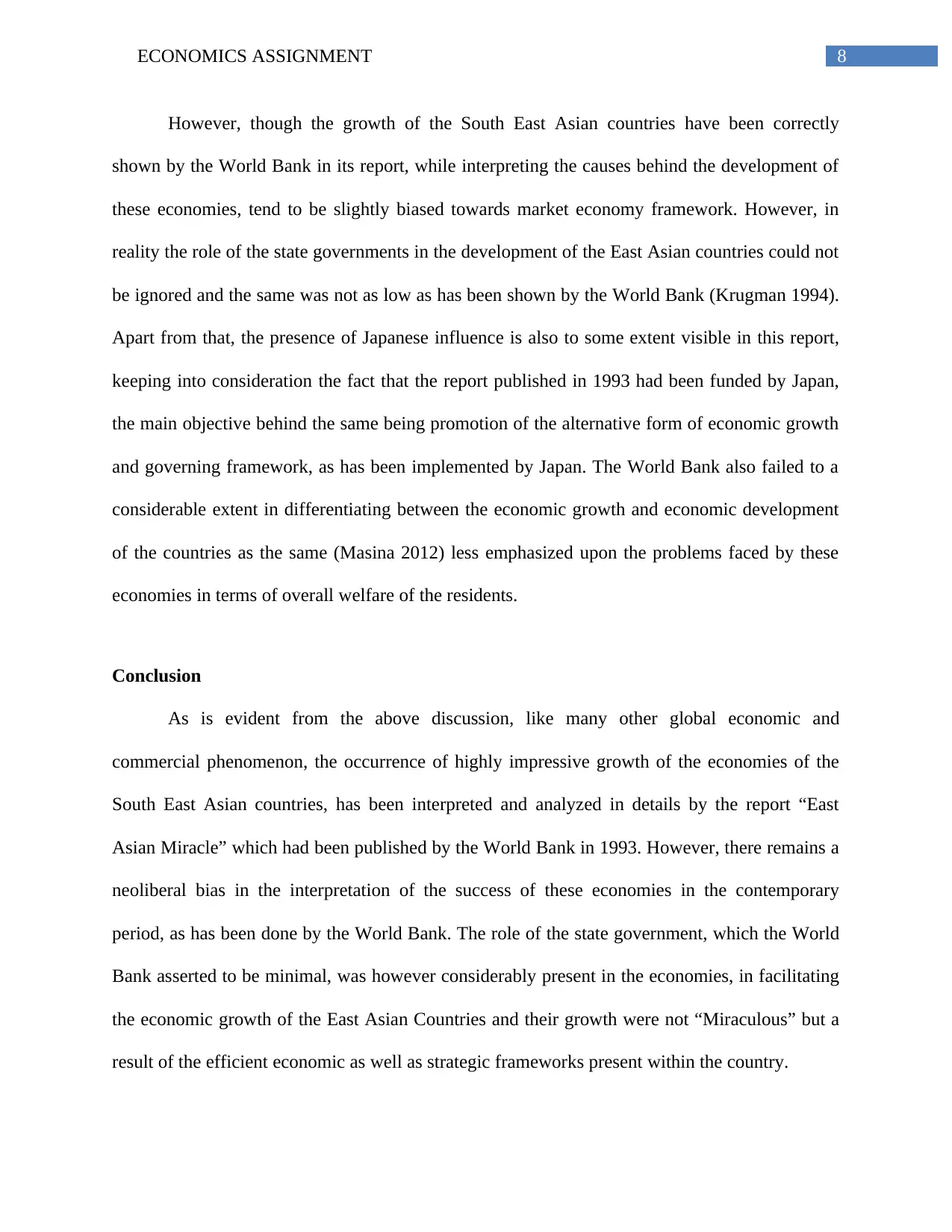
8ECONOMICS ASSIGNMENT
However, though the growth of the South East Asian countries have been correctly
shown by the World Bank in its report, while interpreting the causes behind the development of
these economies, tend to be slightly biased towards market economy framework. However, in
reality the role of the state governments in the development of the East Asian countries could not
be ignored and the same was not as low as has been shown by the World Bank (Krugman 1994).
Apart from that, the presence of Japanese influence is also to some extent visible in this report,
keeping into consideration the fact that the report published in 1993 had been funded by Japan,
the main objective behind the same being promotion of the alternative form of economic growth
and governing framework, as has been implemented by Japan. The World Bank also failed to a
considerable extent in differentiating between the economic growth and economic development
of the countries as the same (Masina 2012) less emphasized upon the problems faced by these
economies in terms of overall welfare of the residents.
Conclusion
As is evident from the above discussion, like many other global economic and
commercial phenomenon, the occurrence of highly impressive growth of the economies of the
South East Asian countries, has been interpreted and analyzed in details by the report “East
Asian Miracle” which had been published by the World Bank in 1993. However, there remains a
neoliberal bias in the interpretation of the success of these economies in the contemporary
period, as has been done by the World Bank. The role of the state government, which the World
Bank asserted to be minimal, was however considerably present in the economies, in facilitating
the economic growth of the East Asian Countries and their growth were not “Miraculous” but a
result of the efficient economic as well as strategic frameworks present within the country.
However, though the growth of the South East Asian countries have been correctly
shown by the World Bank in its report, while interpreting the causes behind the development of
these economies, tend to be slightly biased towards market economy framework. However, in
reality the role of the state governments in the development of the East Asian countries could not
be ignored and the same was not as low as has been shown by the World Bank (Krugman 1994).
Apart from that, the presence of Japanese influence is also to some extent visible in this report,
keeping into consideration the fact that the report published in 1993 had been funded by Japan,
the main objective behind the same being promotion of the alternative form of economic growth
and governing framework, as has been implemented by Japan. The World Bank also failed to a
considerable extent in differentiating between the economic growth and economic development
of the countries as the same (Masina 2012) less emphasized upon the problems faced by these
economies in terms of overall welfare of the residents.
Conclusion
As is evident from the above discussion, like many other global economic and
commercial phenomenon, the occurrence of highly impressive growth of the economies of the
South East Asian countries, has been interpreted and analyzed in details by the report “East
Asian Miracle” which had been published by the World Bank in 1993. However, there remains a
neoliberal bias in the interpretation of the success of these economies in the contemporary
period, as has been done by the World Bank. The role of the state government, which the World
Bank asserted to be minimal, was however considerably present in the economies, in facilitating
the economic growth of the East Asian Countries and their growth were not “Miraculous” but a
result of the efficient economic as well as strategic frameworks present within the country.
⊘ This is a preview!⊘
Do you want full access?
Subscribe today to unlock all pages.

Trusted by 1+ million students worldwide
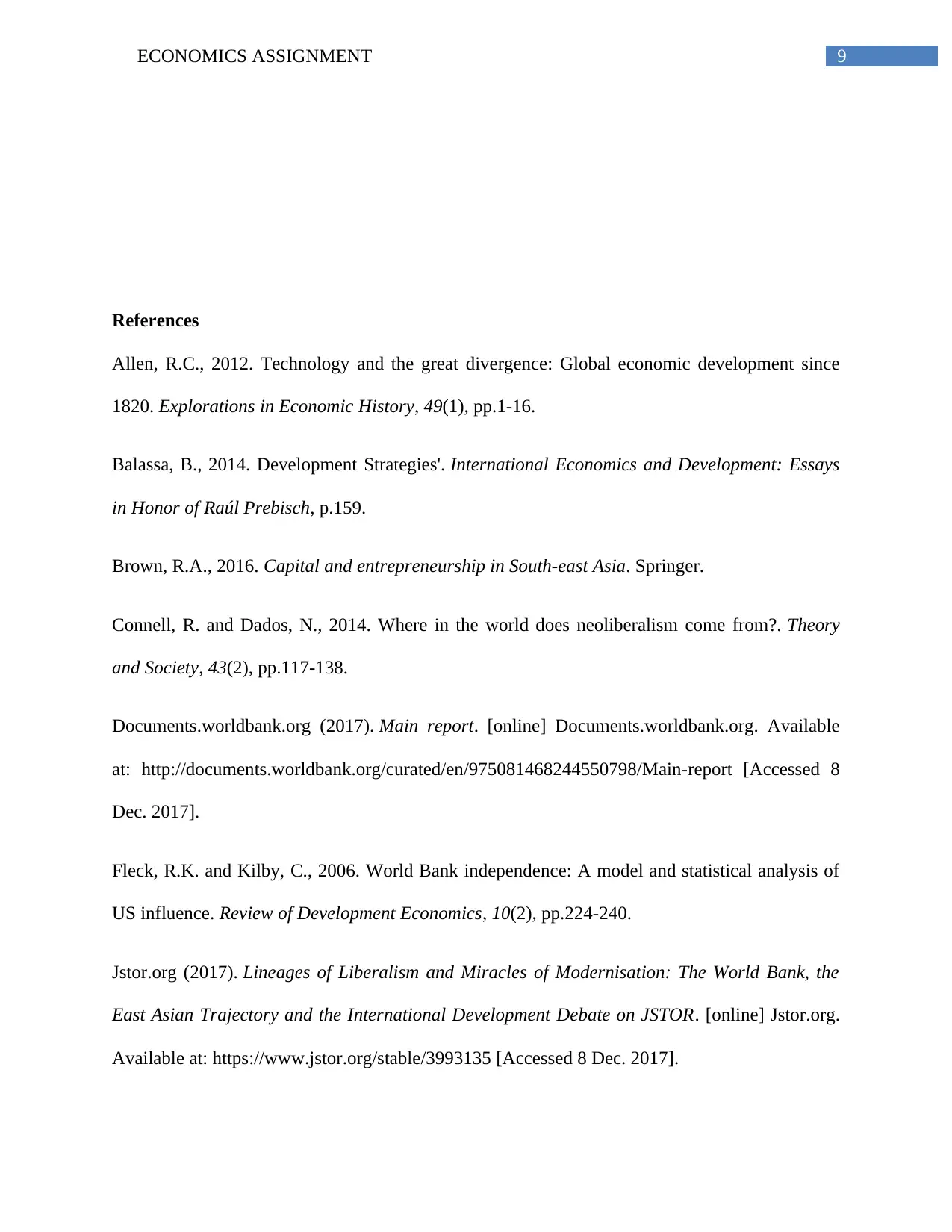
9ECONOMICS ASSIGNMENT
References
Allen, R.C., 2012. Technology and the great divergence: Global economic development since
1820. Explorations in Economic History, 49(1), pp.1-16.
Balassa, B., 2014. Development Strategies'. International Economics and Development: Essays
in Honor of Raúl Prebisch, p.159.
Brown, R.A., 2016. Capital and entrepreneurship in South-east Asia. Springer.
Connell, R. and Dados, N., 2014. Where in the world does neoliberalism come from?. Theory
and Society, 43(2), pp.117-138.
Documents.worldbank.org (2017). Main report. [online] Documents.worldbank.org. Available
at: http://documents.worldbank.org/curated/en/975081468244550798/Main-report [Accessed 8
Dec. 2017].
Fleck, R.K. and Kilby, C., 2006. World Bank independence: A model and statistical analysis of
US influence. Review of Development Economics, 10(2), pp.224-240.
Jstor.org (2017). Lineages of Liberalism and Miracles of Modernisation: The World Bank, the
East Asian Trajectory and the International Development Debate on JSTOR. [online] Jstor.org.
Available at: https://www.jstor.org/stable/3993135 [Accessed 8 Dec. 2017].
References
Allen, R.C., 2012. Technology and the great divergence: Global economic development since
1820. Explorations in Economic History, 49(1), pp.1-16.
Balassa, B., 2014. Development Strategies'. International Economics and Development: Essays
in Honor of Raúl Prebisch, p.159.
Brown, R.A., 2016. Capital and entrepreneurship in South-east Asia. Springer.
Connell, R. and Dados, N., 2014. Where in the world does neoliberalism come from?. Theory
and Society, 43(2), pp.117-138.
Documents.worldbank.org (2017). Main report. [online] Documents.worldbank.org. Available
at: http://documents.worldbank.org/curated/en/975081468244550798/Main-report [Accessed 8
Dec. 2017].
Fleck, R.K. and Kilby, C., 2006. World Bank independence: A model and statistical analysis of
US influence. Review of Development Economics, 10(2), pp.224-240.
Jstor.org (2017). Lineages of Liberalism and Miracles of Modernisation: The World Bank, the
East Asian Trajectory and the International Development Debate on JSTOR. [online] Jstor.org.
Available at: https://www.jstor.org/stable/3993135 [Accessed 8 Dec. 2017].
Paraphrase This Document
Need a fresh take? Get an instant paraphrase of this document with our AI Paraphraser
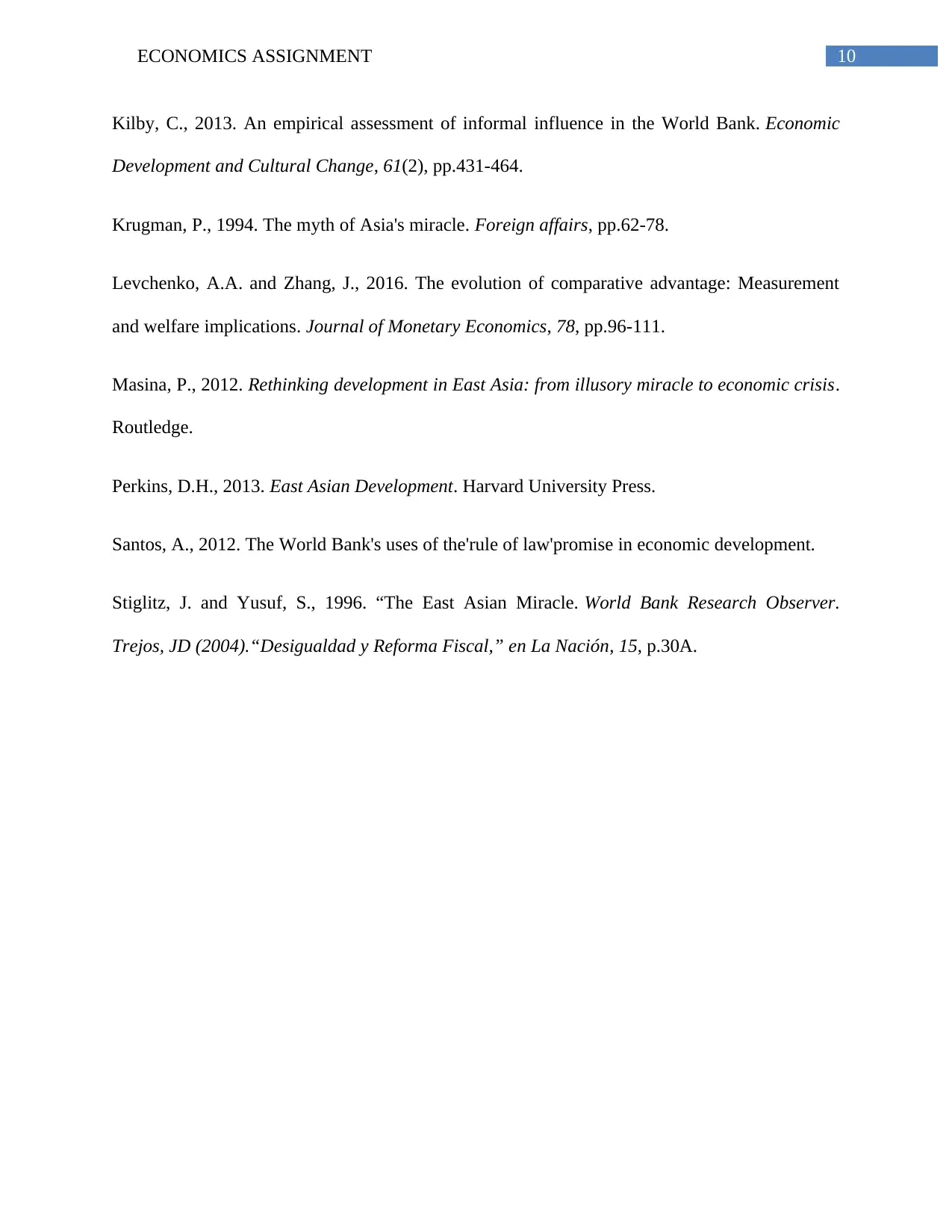
10ECONOMICS ASSIGNMENT
Kilby, C., 2013. An empirical assessment of informal influence in the World Bank. Economic
Development and Cultural Change, 61(2), pp.431-464.
Krugman, P., 1994. The myth of Asia's miracle. Foreign affairs, pp.62-78.
Levchenko, A.A. and Zhang, J., 2016. The evolution of comparative advantage: Measurement
and welfare implications. Journal of Monetary Economics, 78, pp.96-111.
Masina, P., 2012. Rethinking development in East Asia: from illusory miracle to economic crisis.
Routledge.
Perkins, D.H., 2013. East Asian Development. Harvard University Press.
Santos, A., 2012. The World Bank's uses of the'rule of law'promise in economic development.
Stiglitz, J. and Yusuf, S., 1996. “The East Asian Miracle. World Bank Research Observer.
Trejos, JD (2004).“Desigualdad y Reforma Fiscal,” en La Nación, 15, p.30A.
Kilby, C., 2013. An empirical assessment of informal influence in the World Bank. Economic
Development and Cultural Change, 61(2), pp.431-464.
Krugman, P., 1994. The myth of Asia's miracle. Foreign affairs, pp.62-78.
Levchenko, A.A. and Zhang, J., 2016. The evolution of comparative advantage: Measurement
and welfare implications. Journal of Monetary Economics, 78, pp.96-111.
Masina, P., 2012. Rethinking development in East Asia: from illusory miracle to economic crisis.
Routledge.
Perkins, D.H., 2013. East Asian Development. Harvard University Press.
Santos, A., 2012. The World Bank's uses of the'rule of law'promise in economic development.
Stiglitz, J. and Yusuf, S., 1996. “The East Asian Miracle. World Bank Research Observer.
Trejos, JD (2004).“Desigualdad y Reforma Fiscal,” en La Nación, 15, p.30A.
1 out of 11
Related Documents
Your All-in-One AI-Powered Toolkit for Academic Success.
+13062052269
info@desklib.com
Available 24*7 on WhatsApp / Email
![[object Object]](/_next/static/media/star-bottom.7253800d.svg)
Unlock your academic potential
Copyright © 2020–2025 A2Z Services. All Rights Reserved. Developed and managed by ZUCOL.




